Mega, your Guns look first class.
-

Win a Free Custom Engraved Brass Coin!!!
As a way to introduce our brass coins to the community, we will raffle off a free coin during the month of August. Follow link ABOVE for instructions for entering.
You are using an out of date browser. It may not display this or other websites correctly.
You should upgrade or use an alternative browser.
You should upgrade or use an alternative browser.
1:20 Scale Victory & Constitution Gun Models by Signet [COMPLETED BUILD]
Thank you very much!Mega, your Guns look first class.
I have a question for y'all (being from South Carolina). How can I produce simulate caulking between planks at this scale? I have some 0.4" wide planking material that I can use, which simulates 8" wide boards. Guessing that caulk might be 3/8" to 1/2" wide, that would require 0.019" to 0.025" thick caulking. Obviously, the ink/paint on the edge won't work. I have some 0.30" black styrene sheet which isn't bad, but not enough of it, and I hate to buy another Evergreen sheet assortment hoping to get another in that size.
All paper and cardstock I have found is too thin. Most black construction board, presentation board, and poster board appears to have a white or non-black core. Railroad board (yeah, there is such a thing) appears to be solid color, but I haven't found it more than about 0.14" and in packs of 25 sheets. I figure I need 25 square inches! I could try two thicknesses of black construction paper (or 3). But I don't know how multiple sheets would look.
Anyhow, I'd love to hear ideas on how best to do this.
All paper and cardstock I have found is too thin. Most black construction board, presentation board, and poster board appears to have a white or non-black core. Railroad board (yeah, there is such a thing) appears to be solid color, but I haven't found it more than about 0.14" and in packs of 25 sheets. I figure I need 25 square inches! I could try two thicknesses of black construction paper (or 3). But I don't know how multiple sheets would look.
Anyhow, I'd love to hear ideas on how best to do this.
Last edited:
I use a soft lead pencil to darken the edges. Whatever method you decide on, try it on scrap first.I have a question for y'all (being from South Carolina). How can I produce simulate caulking between planks at this scale? I have some 0.4" wide planking material that I can use, which simulates 8" wide boards. Guessing that caulk might be 3/8" to 1/2" wide, that would require 0.19" to 0.25" thick caulking. Obviously, the ink/paint on the edge won't work. I have some 0.30" black styrene sheet which isn't bad, but not enough of it, and I hate to buy another Evergreen sheet assortment hoping to get another in that size.
All paper and cardstock I have found is too thin. Most black construction board, presentation board, and poster board appears to have a white or non-black core. Railroad board (yeah, there is such a thing) appears to be solid color, but I haven't found it more than about 0.14" and in packs of 25 sheets. I figure I need 25 square inches! I could try two thicknesses of black construction paper (or 3). But I don't know how multiple sheets would look.
Anyhow, I'd love to hear ideas on how best to do this.
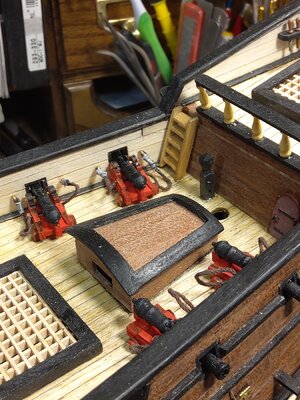
How about strips cut from a black vinyl folder? Might find something thick enough at Michaels/Hobby Lobby/Office Max...
That is certainly a good and accepted method for smaller scale, but for 1:20 scale, I think I need something substantially thicker.I use a soft lead pencil to darken the edges. Whatever method you decide on, try it on scrap first.
Try something. Construction paper? Black paint? Be careful if you try to use a Sharpie - the ink can run along the grain...That is certainly a good and accepted method for smaller scale, but for 1:20 scale, I think I need something substantially thicker.
A good thought! So I immediately checked my wife's supply of colorful (but vinyl) folders, and they're around 0.012", or scale 0.24", a bit thin I think. I was going to look at a couple sheets of color construction paper, and grabbed the back cardboard piece from a pack of paper: not bad! A light brown color, that gets darker when Danish Oil is applied (or any finish, I would think). Just clamped in place, it doesn't look too bad:How about strips cut from a black vinyl folder? Might find something thick enough at Michaels/Hobby Lobby/Office Max...
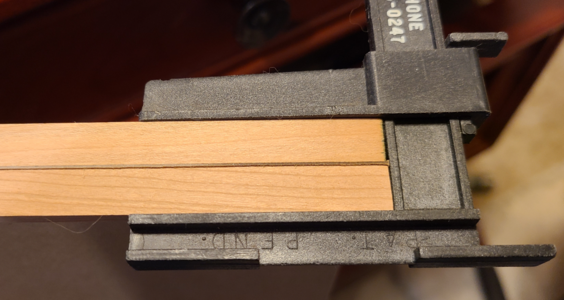
It's sticking up a bit; I would take care that it wasn't, or sand it along with the wood. I actually think it might work fine. And looking at some tablets I have, I've now come up with these thicknesses:
0.020" - 0.40" Scale
0.024" - 0.48" Scale (just under 1/2", shown above)
0.029" - 0.58" Scale
0.032" - 0.64" Scale
0.040" - 0.80" Scale
Any of them, I think, provide enough contrast when finished, and not a bad texture, either. So, what thickness do you think is most correct to represent a caulk gap on a ship such as the Victory?
Tried another method: my wife, who does jewelry, had some waxy-feeling cord about 0.035" in diameter. Pressed between the two pieces of wood, it looks good:
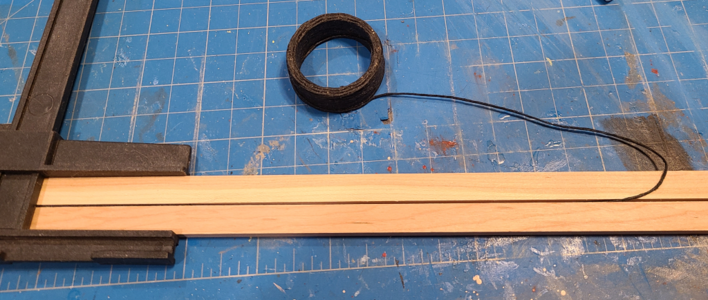
The problem I see with it is providing enough space for the thread to go in, but not enough that it falls below the surface. That would be pretty easy if "boards" were full length, but tougher cut to length.

The problem I see with it is providing enough space for the thread to go in, but not enough that it falls below the surface. That would be pretty easy if "boards" were full length, but tougher cut to length.
Kurt Konrath
Kurt Konrath
For the thread idea try sanding a slight taper to top edge of both side of plank.
When two are side by side it would leave a slight V grove to glue thread into below top surface.
Instead of sanding when ass is assembled try applying a layer of thin CA over the entire top surface. Then use metal blade to scrap the wood down to bare wood as the CA seals the wood and scrapping give a smooth level surface.
To scrap try a single edge razor blade heals near 90 to surface and pull along the grain
I have seen this method done by several modelers here
Try on scrap first
When two are side by side it would leave a slight V grove to glue thread into below top surface.
Instead of sanding when ass is assembled try applying a layer of thin CA over the entire top surface. Then use metal blade to scrap the wood down to bare wood as the CA seals the wood and scrapping give a smooth level surface.
To scrap try a single edge razor blade heals near 90 to surface and pull along the grain
I have seen this method done by several modelers here
Try on scrap first
Hello Signet I find both versions very beautiful.
I have some 0.4" wide planking material that I can use, which simulates 8" wide boards. Guessing that caulk might be 3/8" to 1/2" wide, that would require 0.19" to 0.25" thick caulking.
require 0.19" to 0.25" thick caulking.
I am not fully experienced with the measures, but I think there is a typewriting error...... tranfered to metric would be appr. 5mm wide caulking which is half the width of the plank.
When I calculate I guess something around 0,5mm would be a correct thickness when the planking board has appr. 1cm width.
This material would fit to the needs
Blackboard 0.5 mm - buy now on architekturbedarf.de
Blackboard 0.5 mm 70 x 100 cm, matt black
www.architekturbedarf.de
In german "Modellbaupappe" named "blackboard"
It is pressed paper with 0,5mm thickness - completely blackened
Blackboard 0,5 mm
70 x 100 cm, matt black
Product Information
Blackboards are valued for their rich, consistent black colour. Ideal for model making or as presentation cardboard.
Details:
- matte, consistent black
- acid-free
- long grain
- highly smooth surface
I was going to suggest some of the larger black line used for our rigging. If you back the planks with something like tape or card stock, the line won't fall through. The tape would even help hold in place until you affix it. All of these above are great ideas too.
Sorry, I didn't add enough zeros. That should have read "0.019" to 0.025". I've corrected the original.I am not fully experienced with the measures, but I think there is a typewriting error...... tranfered to metric would be appr. 5mm wide caulking which is half the width of the plank.
That's close to what I was saying (or trying to). My 0.4" wide planks are 1.02 cm and 3/8" to 1/2" caulking in 1:20 scale would be 0.48 to 0.63mm.When I calculate I guess something around 0,5mm would be a correct thickness when the planking board has appr. 1cm width.
Yes, it would probably work. I'm having trouble finding an equivalent in the US, and hate to buy, and pay shipping for, a square meter when I need about 25 square inches. (Note: Do you all hate that the States are still not using the metric system as much as many of us do? I wonder how long this can go on? Even England has changed!)This material would fit to the needs
Blackboard 0.5 mm - buy now on architekturbedarf.de
Blackboard 0.5 mm 70 x 100 cm, matt blackwww.architekturbedarf.de
In german "Modellbaupappe" named "blackboard"
It is pressed paper with 0,5mm thickness - completely blackened
Thanks for your comments and suggestions.
Thanks for your thoughts. I am using thicker than normal planking, because it's what I have, and it is creating a base, not a part of a ship. So my planks are 0.2" or about 5mm thick. So the thread wouldn't fall through the "deck" to the area below (between cross beams), it would just fall below the surface, and look incorrect, and might be difficult to lift back up.I was going to suggest some of the larger black line used for our rigging. If you back the planks with something like tape or card stock, the line won't fall through. The tape would even help hold in place until you affix it. All of these above are great ideas too.
That's a good idea. Even if the planks were just rounded a bit, the thread would still fall into place more easily. Although I was thinking/hoping just applying a varnish would hold the thread in place, rather than gluing.For the thread idea try sanding a slight taper to top edge of both side of plank.
When two are side by side it would leave a slight V grove to glue thread into below top surface.
I have seen this done by others, too, in particular Olha. She has used it to simulate nails or treenails in decking, by just denting or pricking the surface first, but I have never understood the appeal of it. First, because of the large amount of CA used (not cheap) and second because of all the work to scrape it back off. And I dislike the gloss appearance of CA on wood, and tend to think it would be difficult to remove completely.Instead of sanding when ass is assembled try applying a layer of thin CA over the entire top surface. Then use metal blade to scrap the wood down to bare wood as the CA seals the wood and scrapping give a smooth level surface.
To scrap try a single edge razor blade heals near 90 to surface and pull along the grain
I have seen this method done by several modelers here
Anyhow, thank you for your thoughts and suggestions.
Kurt Konrath
Kurt Konrath
Try applying a varnish and let it get a bit tacky and then add the string to hold it down, may work for you, and then I would add another coat on top to seal the string. Test and let us know, you are showing many old shipwrights new ways of doing old things. 
That is a good idea.Try applying a varnish and let it get a bit tacky and then add the string to hold it down, may work for you, and then I would add another coat on top to seal the string.
Thanks, although it's more a less experienced modeler trying to come with something decent by using stuff on hand.Test and let us know, you are showing many old shipwrights new ways of doing old things.
I'm still leaning toward using cardboard that I have on hand, if the result is okay. It's easy to use, stays in place, and, well, it's worth a try. I chose some 0.025" thick light brown cardboard, simulating a 1/2" wide caulking seam, and glued up a small sample:
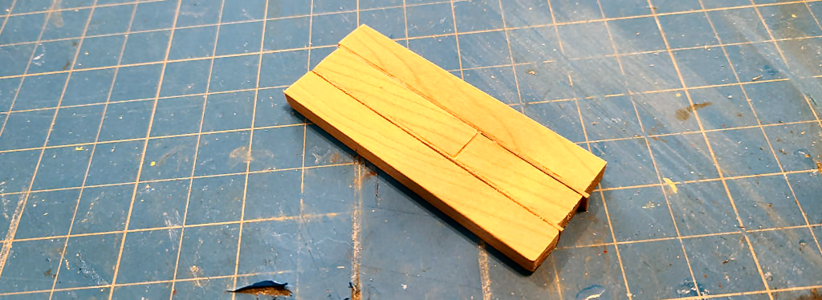
It's just the cherry wood glued to cardboard strip to cherry wood, alternating. Got some glue on the cardboard. In the final work, the wood strips will be glued to the base, with the cardboard between, needing little or no glue, I think.
After sanding a bit, I applied some MinWax Wipe-On Poly with a rag:
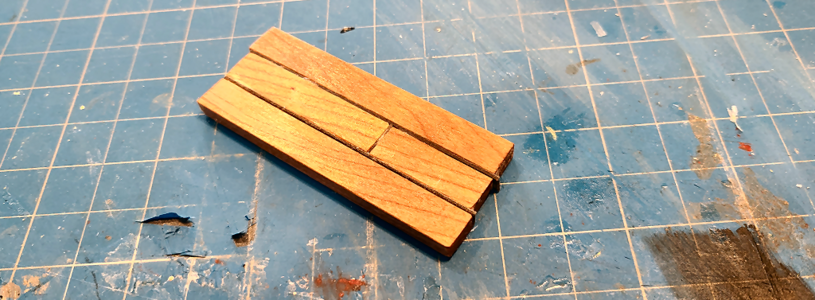
I thought it looked pretty good, by eye, until I look at the photo. Looks like the cardboard might have squished out a bit during sanding, but if you stand back 10' or so from your screen, it looks okay.
Would it look better in black? Yes, I'm thinking it might. Although I also think it would really draw attention to the decking, and the centerpiece is to be the guns. Having the background decking muted a bit like shown I think might look pretty good. BTW, the above wood is slightly narrower than I will be using; it is 0.35" wide while the main deck will use 0.39" strips. I'll use the narrower pieces on each side to get the proper fit under the plexiglass.
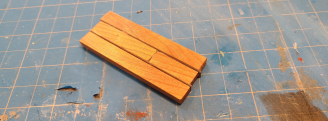
There. Does that look better?

It's just the cherry wood glued to cardboard strip to cherry wood, alternating. Got some glue on the cardboard. In the final work, the wood strips will be glued to the base, with the cardboard between, needing little or no glue, I think.
After sanding a bit, I applied some MinWax Wipe-On Poly with a rag:

I thought it looked pretty good, by eye, until I look at the photo. Looks like the cardboard might have squished out a bit during sanding, but if you stand back 10' or so from your screen, it looks okay.
Would it look better in black? Yes, I'm thinking it might. Although I also think it would really draw attention to the decking, and the centerpiece is to be the guns. Having the background decking muted a bit like shown I think might look pretty good. BTW, the above wood is slightly narrower than I will be using; it is 0.35" wide while the main deck will use 0.39" strips. I'll use the narrower pieces on each side to get the proper fit under the plexiglass.

There. Does that look better?
- Joined
- Oct 17, 2020
- Messages
- 1,690
- Points
- 488

Ciap Sigillo, why don't you try carbon paper?I'm still leaning toward using cardboard that I have on hand, if the result is okay. It's easy to use, stays in place, and, well, it's worth a try. I chose some 0.025" thick light brown cardboard, simulating a 1/2" wide caulking seam, and glued up a small sample:
View attachment 347185
It's just the cherry wood glued to cardboard strip to cherry wood, alternating. Got some glue on the cardboard. In the final work, the wood strips will be glued to the base, with the cardboard between, needing little or no glue, I think.
After sanding a bit, I applied some MinWax Wipe-On Poly with a rag:
View attachment 347186
I thought it looked pretty good, by eye, until I look at the photo. Looks like the cardboard might have squished out a bit during sanding, but if you stand back 10' or so from your screen, it looks okay.
Would it look better in black? Yes, I'm thinking it might. Although I also think it would really draw attention to the decking, and the centerpiece is to be the guns. Having the background decking muted a bit like shown I think might look pretty good. BTW, the above wood is slightly narrower than I will be using; it is 0.35" wide while the main deck will use 0.39" strips. I'll use the narrower pieces on each side to get the proper fit under the plexiglass.
View attachment 347190
There. Does that look better?



